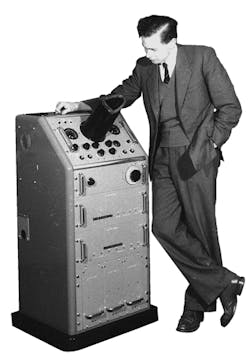The first Type 1 radar system was produced and installed on a fishing trawler in 1947. It would become the first type-approved radar of any kind, earning a type-approval certificate in August 1948 (see photo). Kelvin Hughes (www.kelvinhughes.com), a company with a 250-year history, is proud of having produced that navigation radar system and achieving a milestone in maritime history. The firm has developed radar systems for commercial ships, fishing vessels, coast-guard patrol vessels, and warships.
One of the significant technology developments by Kelvin Hughes in the ensuing years was the launch of the SharpEye navigation radar in 2006, a fully solid-state electronic system that did away with the vacuum-tube magnetron as the microwave signal source. Although magnetrons had served well as high-power pulsed RF/microwave signal sources in a number of radar types since those early years, the use of solid-state oscillators and amplifiers brought a significant reduction in size, weight, and power consumption, along with a major improvement in reliability.
In 2010, the firm brought the SharpEye technology to Vessel Traffic Service (VTS) and coastal surveillance applications, the first time that solid-state technology had been available to these markets. Most recently, in 2013, the company launched the first upmast multipurpose navigation radar located in a carbon composite housing with low radar cross-section (RCS) characteristics. That same year, the company also launched the SharpEye SxV system, a pulse Doppler radar system with full 360-deg. coverage of both ground surveillance and marine security applications.
Of course, these are just a handful of the technology advances that have occurred during the rich history of radar technology. Solid-state technology continues to advance, with semiconductor technologies such as gallium nitride (GaN) providing higher power levels from higher-frequency transistors and integrated circuits (ICs). In turn, system designers continue to look to improvements in antenna architectures and digital signal processing to learn how to make the best use of new RF/microwave capabilities.
About the Author
Jack Browne
Technical Contributor
Jack Browne, Technical Contributor, has worked in technical publishing for over 30 years. He managed the content and production of three technical journals while at the American Institute of Physics, including Medical Physics and the Journal of Vacuum Science & Technology. He has been a Publisher and Editor for Penton Media, started the firm’s Wireless Symposium & Exhibition trade show in 1993, and currently serves as Technical Contributor for that company's Microwaves & RF magazine. Browne, who holds a BS in Mathematics from City College of New York and BA degrees in English and Philosophy from Fordham University, is a member of the IEEE.

